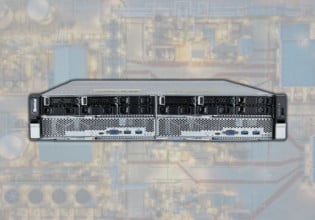The Power of Invisibility: Infrared Sensors for Automation
Operating just outside the visible light spectrum, infrared energy emits from anything with heat stored in it. Detecting this energy, infrared sensors find use in applications from proximity detection to temperature measurement.
See Our Previous Articles on Industrial Sensors:
- Introduction to Industrial Sensors
- The Basics of Optical Sensors and Common Types
- Lasers and Their Uses in Sensing and Object Detecting
Before diving into infrared sensors, let us review the underlying concept of electromagnetic energy. Electromagnetic energy can travel long distances and expands as it moves along a continuum. There is a broad range of wavelengths that define what is called the electromagnetic spectrum. The electromagnetic spectrum is divided into different categories depending on the signal's wavelength.
In fact, light is a form of electromagnetic energy that exists within a specific wavelength range. In this context, it is called visible light because it is the only range the human eye can see. Visible light and all of its colors exist between 380 and 700 nanometers of wavelength. Previously, we covered sensors that operate within the visible light spectrum.
Figure 1. The electromagnetic wavelength spectrums (click to enlarge). Image used courtesy of NASA Science
The infrared spectrum exists just beyond the visible light between 780 nanometers and 1-millimeter wavelengths. Although imperceivable by the human eye, infrared is still considered a form of light and part of the optical window. Humans perceive infrared waves in the form of heat.
Practically anything with some amount of heat stored in it emits infrared energy and can be detected using infrared sensors. In other words, anything that is above the absolute zero temperature is capable of emitting infrared waves.
Infrared-based technology has numerous applications outside of industrial automation. For example, TV remote controllers send an infrared signal to a receiver in the TV to execute a desired command. It has also proven beneficial in astronomy, where scientists can now detect cooler objects at farther distances by looking for their infrared emissions.

Figure 2. Visible light and infrared imagery of Carina Nebula obtained by the Hubble telescope. Image used courtesy of NASA
An important advantage of infrared waves is that they suffer far less disruption when passing through dense layers of gasses and dust. This is not only useful in astronomy but also in industrial applications.
Infrared Sensor Types
There are two types of infrared sensors, which will be described next.
Active Infrared Sensor
An active infrared sensor consists of two basic elements: an emitter and a detector. Typically, the emitter is an infrared light-emitting diode (IR LED) used as a light source. An IR LED consumes low amounts of energy and generates very low amounts of heat.
Like an optical sensor, an IR LED-based sensor interprets the light beam reflected into the receiver from a detected surface.

Figure 3. An active two-beam infrared barrier sensor. Image used courtesy of Intelbras
Passive Infrared Sensor
A passive sensor consists only of a detector, and no transmitter is used. The detectors can sense heat energy levels generated by objects and people. Passive IR sensors are very popular in security and motion detection applications.

Figure 4. Passive infrared motion sensors are widely used in home security and automation. Image used courtesy of Steinel
Infrared Sensor Applications
This section will review some of the most popular applications of infrared sensors.
Infrared Proximity Sensor
Proximity detection is likely the most common application of IR sensors. Their greatest advantage is that they are contactless and therefore don’t cause any friction or potential damage to the measured surface and extend the sensor’s life.
Also, they suffer very little to no interference from surrounding machinery and are relatively low-cost. Because of their resilience against interference, these sensors are well-suited for underwater and oil applications.
The distance between the sensor and the surface is calculated based on the intensity of the light beam reflected back to the receiver.
Infrared Thermometer
Measuring temperature is another key application of IR devices. They offer the same advantages as proximity sensors: they are contactless and low-cost.
Infrared thermometers work by analyzing the thermal radiation emanating from the measured surface. One disadvantage is that the sensor readings are prone to errors caused by capturing the measurements and radiation of unintended surfaces.
Infrared thermal sensors are used to conduct a thermal survey of a surface to detect hot spots. This is an important function for monitoring materials, especially in applications that involve frequent heating and cooling.
The most recognizable application is perhaps the thermal gun. To interpret human body temperature, these guns can measure the temperature of many surfaces, including human skin.

Figure 5. An infrared thermal gun. Image used courtesy of Adobe Stock
Other Applications of Infrared Sensing
There are many more applications of infrared sensors, some of which will be covered in future articles in this series. Below is a list of some of these applications.
- Gas Analysis: Gas analyzers can help determine gas density based on how much of the IR beam is absorbed by the gaseous medium.
- IR Tracking: This is a military application in which the IR radiation coming from a target guides a weapon or missile.
- Night Vision: Night vision is enabled by IR sensor amplification.
- Item Counter: A variation of the proximity detection that counts up as soon as the radiated beam of the sensor is interrupted by the objects being counted.
Sensors in Industrial Automation
In the next article in our series, we will take a closer look at thermometer sensors and the types used in industrial automation.







